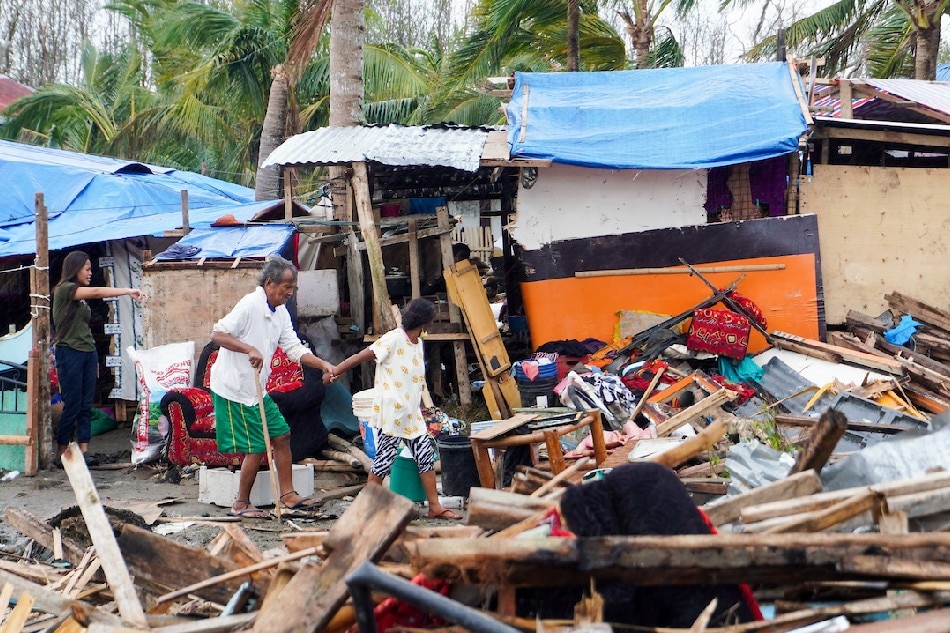PAGASA redefines 'super typhoon', revises wind signals | ABS-CBN
ADVERTISEMENT

Welcome, Kapamilya! We use cookies to improve your browsing experience. Continuing to use this site means you agree to our use of cookies. Tell me more!
PAGASA redefines 'super typhoon', revises wind signals
PAGASA redefines 'super typhoon', revises wind signals
Ariel Rojas,
ABS-CBN News
Published Mar 23, 2022 01:24 PM PHT
|
Updated Mar 23, 2022 01:39 PM PHT
MANILA — State weather bureau PAGASA on Wednesday revised its definition of a "super typhoon" and its system for alerting the public on the wind strength of tropical cyclones.
MANILA — State weather bureau PAGASA on Wednesday revised its definition of a "super typhoon" and its system for alerting the public on the wind strength of tropical cyclones.
A super typhoon packs maximum sustained winds of at least 185 kilometers per hour, based on PAGASA’s revised definition.
A super typhoon packs maximum sustained winds of at least 185 kilometers per hour, based on PAGASA’s revised definition.
Previously, PAGASA defined a super typhoon as a tropical cyclone with more than 220 kph maximum sustained winds.
Previously, PAGASA defined a super typhoon as a tropical cyclone with more than 220 kph maximum sustained winds.
The new definition is similar to the USA Joint Typhoon Warning Center's super typhoon classification, when converted to 10-minute averaging.
The new definition is similar to the USA Joint Typhoon Warning Center's super typhoon classification, when converted to 10-minute averaging.
ADVERTISEMENT
PAGASA introduced this category in 2015 to better reflect the potential dangers of super typhoons like Yolanda, the strongest storm to ever hit land, which left more than 7,360 people dead or missing across central Philippines in 2013.
PAGASA introduced this category in 2015 to better reflect the potential dangers of super typhoons like Yolanda, the strongest storm to ever hit land, which left more than 7,360 people dead or missing across central Philippines in 2013.
The state weather bureau also amended its tropical cyclone wind signals, which now correspond to the following categories.
The state weather bureau also amended its tropical cyclone wind signals, which now correspond to the following categories.
Tropical Depression
Less than 62 kilometers per hour maximum sustained winds
Highest wind signal: 1
Tropical Depression
Less than 62 kilometers per hour maximum sustained winds
Highest wind signal: 1
Tropical Storm
62-88 kph maximum sustained winds
Highest wind signal: 2
Tropical Storm
62-88 kph maximum sustained winds
Highest wind signal: 2
Severe Tropical Storm
89-117 kph maximum sustained winds
Highest wind signal: 3
Severe Tropical Storm
89-117 kph maximum sustained winds
Highest wind signal: 3
ADVERTISEMENT
Typhoon
118-184 kph maximum sustained winds
Highest wind signal: 4
Typhoon
118-184 kph maximum sustained winds
Highest wind signal: 4
Super Typhoon
185 kph or higher maximum sustained winds
Highest wind signal: 5
Super Typhoon
185 kph or higher maximum sustained winds
Highest wind signal: 5
From 2025, they will be replaced with the names Jacinto, Mirasol, and Opong, respectively.
From 2025, they will be replaced with the names Jacinto, Mirasol, and Opong, respectively.
LOOK: @dost_pagasa announces the decommissioning of tropical cyclone names Jolina, Maring, & Odette during its Scientific Forum this morning.
Their replacement names will be Jacinto, Mirasol, & Opong, respectively, which will be used starting in the 2025 season. pic.twitter.com/VWRGcxJ7Mz
— Ariel Rojas (@arielrojasPH) March 23, 2022
LOOK: @dost_pagasa announces the decommissioning of tropical cyclone names Jolina, Maring, & Odette during its Scientific Forum this morning.
— Ariel Rojas (@arielrojasPH) March 23, 2022
Their replacement names will be Jacinto, Mirasol, & Opong, respectively, which will be used starting in the 2025 season. pic.twitter.com/VWRGcxJ7Mz
PAGASA retires the names of tropical cyclones that cause 300 or more deaths, or at least P1 billion of damage to agriculture and infrastructure.
PAGASA retires the names of tropical cyclones that cause 300 or more deaths, or at least P1 billion of damage to agriculture and infrastructure.
ADVERTISEMENT
Forty-seven typhoon names have been decommissioned since the naming scheme was introduced in 2001.
Forty-seven typhoon names have been decommissioned since the naming scheme was introduced in 2001.
Read More:
PAGASA
state weather bureau
tropical cyclone
signal
tropical cyclone wind signal
supertyphoon
typhoon
bagyo
storm
calamity
ADVERTISEMENT
ADVERTISEMENT



